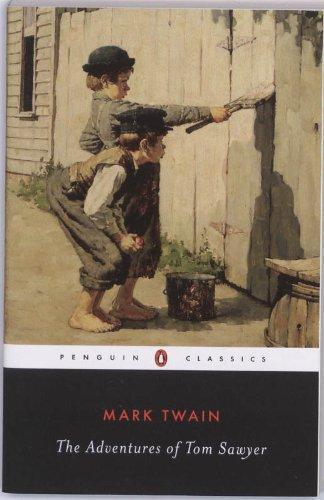Jesse Atkinson reviewed The Adventures of Tom Sawyer by Mark Twain
Review of 'The Adventures of Tom Sawyer' on 'Goodreads'
4 stars
I read this anytime I didn’t know what else to read in elementary. I adore this book.

244 pages
English language
Published Dec. 26, 2006
Mark Twain created the memorable characters Tom Sawyer and Huckleberry Finn drawing from the experiences of boys he grew up with in Missouri. Set by the Mississippi River in the 1840's, it follows these boys as they get into predicament after predicament. Tom's classic whitewashing of the fence has become part of American legend, and the book paints a nostalgic picture of life in the middle of the nineteenth century. Tom runs away from home to an island in the river, chases Injun Joe and his treasure, and even gets trapped in a cave for days with Becky Thatcher. The book is one of Twain's most beloved stories.
I read this anytime I didn’t know what else to read in elementary. I adore this book.
This review is cross-posted from my blog here: timefarer.wordpress.com/2017/03/05/the-adventures-of-tom-sawyer/
One of the most memorable chapters from my childhood English textbooks was Tom Sawyer, fooling his friends to paint a fence. From then on, Tom Sawyer, his buddy Huckleberry Finn, that period of US history and author Mark Twain have continued to appear so many times in my readings that I simply had to pick up this classic when I saw it. On its surface, The Adventures of Tom Sawyer is filled with fun stories centered around Tom, that happen in St. Petersburg, a fictional village along the Mississippi river. Tom seems to have lost his parents a long time ago and is being brought up by his Aunt Polly, a big hearted naive woman and her children Sid and Mary. Tom is a hyper-active clever rascal, who regularly creates trouble at school and gets switched by teachers on …
This review is cross-posted from my blog here: timefarer.wordpress.com/2017/03/05/the-adventures-of-tom-sawyer/
One of the most memorable chapters from my childhood English textbooks was Tom Sawyer, fooling his friends to paint a fence. From then on, Tom Sawyer, his buddy Huckleberry Finn, that period of US history and author Mark Twain have continued to appear so many times in my readings that I simply had to pick up this classic when I saw it. On its surface, The Adventures of Tom Sawyer is filled with fun stories centered around Tom, that happen in St. Petersburg, a fictional village along the Mississippi river. Tom seems to have lost his parents a long time ago and is being brought up by his Aunt Polly, a big hearted naive woman and her children Sid and Mary. Tom is a hyper-active clever rascal, who regularly creates trouble at school and gets switched by teachers on a daily basis. He always wants to be the alpha male at school and is always in love with the prettiest girl in school. He mostly hangs around with Huckleberry Finn, a homeless vagabond child of a drunk father. His idyllic world starts cracking bit by bit once he and Finn witness a murder and what follows after that.
First things first, this is not a moral and social work like To Kill A Mockingbird. This is an entertaining book for children that just happens to have enough elements to engage adults. To me it seemed like the characters and settings were a combination of the mysteries by Enid Blyton and the naughty William Brown series by Richmal Crompton. (Both these authors came after Twain, so his works might have heavily inspired them.) This is not an America I have visited or am familiar with. Here it is always hot and summery, flowers and trees are in bloom, kids are always frolicking in the river or fishing or picnicking and running around barefoot in the village, reluctantly wearing shoes only for Sunday church.
Childhood summer stories always fill my heart with joy, because I cherish that period of my life the most. But, there are lots of interesting hints and passing references to US society of early 1800s which are equally engaging in this book. For example, the servants are always black, referred to as nigger or Negro, as was prevalent at that time. It is seen to be beneath oneself to eat with a Black person, only the homeless Finn says that he has done that and does not mind it. The village does have people of mixed race, like mulattoes and people of Red Indian and white parents. But they are never seen in school or church and are mostly the shady characters. Finn comes from a broken home, where his parents used to fight and have now separated. Tom is parentless. There is no uncle in the house with Aunt Polly. Switching kids as punishment regularly, both at home and school, is the norm. 12-year olds like Tom can drink and smoke a pipe without creating a fuss among adults. The world was so idyllic that kids could roam around for an entire day in forests, miles away from home without parents being unduly worried. The list just goes on. Makes one wonder how much better civilized we are now, but also how much freedom we lost along the way. This American classic is a heartwarming read, full of that manic childhood zest and inquisitiveness and is sure to leave you wanting your carefree days back.
